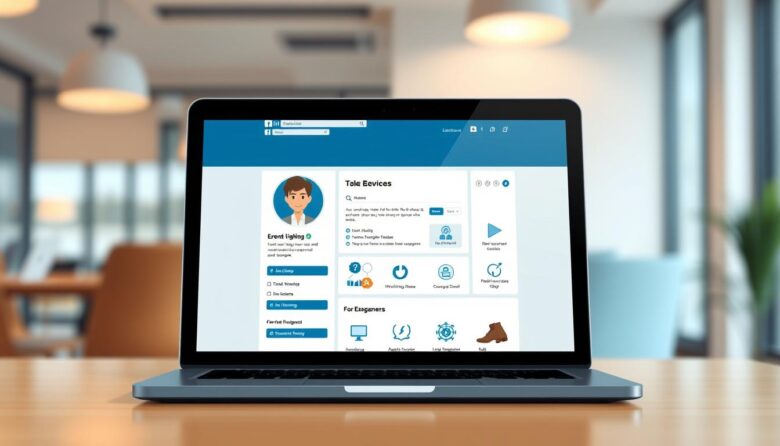LinkedIn has grown into a global professional hub with over 740 million users across 200+ countries. What began as a digital resume platform now serves as a dynamic space for career growth, networking, and personal branding. Crafting a standout presence here requires more than just listing job titles—it demands strategic refinement to connect with the right opportunities and people.
Modern professionals use LinkedIn to showcase expertise, build credibility, and attract meaningful connections. A well-structured page acts like a digital storefront, instantly communicating your value to employers, clients, and collaborators. Key elements like visual consistency, keyword placement, and engaging content work together to boost visibility in search results.
Platform algorithms prioritize complete, activity-rich profiles that align with user search behaviors. Regular updates and thoughtful phrasing help maintain relevance in competitive industries. This approach not only increases discoverability but also fosters trust by demonstrating professionalism and clarity.
Balancing authenticity with technical best practices ensures your page resonates with both humans and search tools. Whether you’re job hunting or expanding your network, a polished LinkedIn presence opens doors to collaborations that align with your career goals.
Understanding the Importance of a Strong Profile
A powerful LinkedIn presence acts as your digital handshake in today’s competitive professional landscape. It’s not just about listing experience—it’s about creating connections that drive opportunities. Start by defining what success looks like for your page, whether that’s attracting recruiters, gaining clients, or building industry influence.
Clarifying Your Professional Goals
Before updating your page, ask: Who needs to see this? and What action should they take? Specific objectives help shape content that converts views into meaningful interactions. For example, sales professionals might prioritize showcasing client success stories, while job seekers emphasize measurable achievements.
Knowing Your Ideal Connections
Effective pages speak directly to their audience’s needs. Research shows decision-makers spend 7 seconds scanning profiles. Use language that aligns with your target’s priorities—technical terms for engineers, ROI-focused statements for executives. This tailored approach builds credibility and makes your value proposition instantly clear.
Regularly analyze connection requests and profile visits to refine your strategy. Patterns in viewer demographics reveal which content resonates most, allowing continuous improvement of your professional brand.
Effective “profile optimization strategies” for Better Visibility
Visibility on LinkedIn isn’t accidental—it’s engineered through strategic content design. Your page must cater to both LinkedIn’s search algorithm and broader search engines like Google. This dual focus requires balancing technical precision with authentic storytelling to resonate with humans and machines alike.
Incorporating Relevant Keywords
Start by identifying terms your audience uses to find experts in your field. Tools like LinkedIn’s search suggestions and Google Trends reveal high-value phrases. Integrate these naturally into your headline, summary, and experience sections.
Avoid keyword stuffing. Instead, focus on context. For example, a project manager might use “Agile workflow development” rather than repeating “project management.” This approach maintains readability while boosting search performance.
Tailoring Content for the U.S. Market
American professionals value direct communication and measurable results. Replace generic statements with specific achievements: “Increased sales by 28% in Q3” outperforms “experienced in sales growth.”
Localize references to align with U.S. business culture. Mention familiar certifications like PMP or HubSpot instead of region-specific credentials. This builds immediate credibility with domestic recruiters and collaborators.
Update industry terminology quarterly. Tech fields evolve rapidly—terms like “AI-driven analytics” carry more weight than outdated phrases in competitive markets.
Optimizing Your Profile Picture and Banner Elements
Visual elements form the cornerstone of impactful LinkedIn presence. Your first impression hinges on how quickly viewers recognize professionalism and relevance. Technical specifications matter: profile photos require 400×400 pixels minimum, with your face occupying 60% of the frame. Background banners need 1584×396 dimensions to display correctly across devices.
Guidelines for a Professional Profile Photo
High-quality headshots build trust instantly. Use neutral backgrounds and professional attire matching your industry. Smile naturally—approachability increases connection requests by up to 36% according to LinkedIn data. Avoid casual shots or distracting elements that dilute your brand message.
Designing an Engaging Background Image
Your banner should reinforce expertise without clutter. Incorporate subtle company logos, industry-related graphics, or taglines that summarize your value. For example, a marketing consultant might feature campaign metrics, while a developer could showcase clean code snippets. Ensure text remains readable on mobile screens.
Consistency between photo and banner creates visual harmony. Colors and fonts should align with your personal or organizational identity. This cohesion makes your page memorable, encouraging visitors to explore your content further.
Crafting a Compelling Headline and About Section
Your LinkedIn headline and About section are prime real estate for capturing attention in crowded feeds. These elements determine whether visitors scroll past or engage with your LinkedIn profile. With limited space, every word must convey value while balancing search-friendly terms and human-centric storytelling.
Creating a Keyword-Rich Headline
Ditch generic job titles. Instead, use the 220-character limit to highlight expertise and outcomes. For example: “Digital Marketing Strategist | Driving 300% ROI Through Data-Driven Campaigns.” This format combines role clarity with measurable impact.
Integrate industry terms your audience searches for. A cybersecurity expert might include “Zero Trust Architecture” rather than just “IT Professional.” Test phrases using LinkedIn’s search bar to identify high-traffic keywords. Place them near the headline’s start for algorithmic priority.
Telling Your Unique Professional Story
The About section needs a strong hook. The first 265 characters should answer: Why should someone care? Start with a bold statement like, “Transforming SaaS startups into market leaders through conversion-focused UX design.”
Share career milestones as narratives, not bullet points. Explain how your skills solved specific problems. A project manager might describe leading remote teams through a product launch during supply chain disruptions. Quantify results where possible to build credibility.
End with a clear call-to-action. “Let’s discuss scaling your e-commerce brand” outperforms vague phrases like “Open to opportunities.” This directs viewer behavior while reinforcing your professional focus.
Enhancing Your Work Experience and Credential Displays
Your career journey deserves more than a bullet-point timeline. The experience section becomes powerful when it tells a story of growth and impact. Focus on outcomes that align with your goals, whether attracting clients or advancing to leadership roles.
Showcasing Achievements and Expertise
Replace generic job duties with measurable wins. Instead of “managed projects,” write “Led 12 cross-functional teams to deliver software upgrades 20% under budget.” Quantifiable results build credibility faster than vague descriptions.
Structure each role with 3-5 concise bullet points. Start with action verbs like “Designed” or “Scaled” to emphasize initiative. Include metrics relevant to your industry—dollar amounts, percentages, or timeframes.
Curate your skills section like a highlight reel. List capabilities directly tied to your target audience’s needs. A graphic designer might prioritize “Brand Identity Development” over basic terms like “Adobe Suite.” Encourage colleagues to endorse these skills—profiles with 10+ endorsements receive 4x more profile views.
Education and certifications validate your knowledge. Highlight advanced degrees or specialized training that sets you apart. For example, “Google Analytics Certified” signals updated expertise in data analysis.
Leveraging Advanced LinkedIn Features
LinkedIn’s hidden tools can transform your page from static to standout. Beyond basic info, these elements boost discoverability and showcase technical savvy. They bridge the gap between human connection and algorithmic favor.
Customizing Your URL and Language Settings
A clean LinkedIn URL (linkedin.com/in/yourname) makes sharing easier and improves search engine rankings. Replace default numbers with your full name or brand keywords. This simple edit creates a professional link for resumes or email signatures.
Enable multilingual settings to connect globally. Adding Spanish or French versions of your LinkedIn profile helps international users understand your expertise. It signals cultural awareness—a key trait for roles in diverse markets.
Utilizing Name Pronunciation and Media Elements
The name pronunciation tool removes guesswork for connections. Record a 10-second clip to ensure colleagues say your name correctly. This builds rapport and demonstrates inclusivity in global teams.
Media uploads turn your page into a portfolio. Attach case studies, slide decks, or product demos to experience sections. Visual proof of work outperforms text descriptions, especially in creative fields like design or marketing.
These features position you as a platform expert. They show you’ve invested time to maximize LinkedIn’s capabilities—a subtle but powerful credibility booster.
Integrating SEO Tactics Across Your Profile
Maximizing your professional reach requires aligning your LinkedIn presence with modern search behaviors. Research shows leaders with refined pages generate 45% more opportunities than peers. This demands technical precision and ongoing adjustments to stay visible across search platforms.
Optimizing for Both LinkedIn and Google
LinkedIn’s algorithm prioritizes complete, keyword-rich pages. Use tools like Google Trends to identify terms your audience uses. For example, “cloud security architect” outperforms generic “IT professional” in tech searches. Apply these phrases naturally in headlines and experience descriptions.
Google indexes LinkedIn pages, so include location-based terms for local opportunities. A Chicago-based marketer might add “Midwest e-commerce specialist” to attract regional clients. Update content every six months to reflect industry shifts and career growth.
Tracking and Adjusting Performance
LinkedIn’s Social Selling Index measures four key areas: brand building, insights sharing, relationship nurturing, and opportunity identification. Scores above 70 indicate strong visibility. Pair this with Google Analytics to see which terms drive external traffic.
Review search appearance weekly. If “content marketing strategist” brings more views than “digital writer,” adjust your headline accordingly. These data-driven tweaks keep your page relevant as algorithms evolve.
Set quarterly reminders to audit skills sections and endorsements. Remove outdated abilities and emphasize emerging ones—like adding “AI prompt engineering” if you work in tech. This proactive approach maintains alignment with market demands.
Final Reflections and Next Steps for a Standout Profile
A dynamic LinkedIn presence isn’t a one-time task but a commitment to growth and connection in the digital age. Regular updates to your page ensure alignment with platform trends and shifting industry standards. Pair this with consistent content sharing—posts, articles, or insightful comments—to reinforce expertise and attract quality connections.
Engagement fuels visibility. Interact with peers’ updates and join discussions in niche groups to stay relevant in your field. This active participation signals to algorithms that you’re a valuable contributor, boosting your content’s reach. Employee advocacy programs offer structured ways to amplify your voice while supporting your company’s brand.
Measure what matters. Track profile views and post performance to identify high-impact areas. Adjust your approach quarterly—swap underperforming topics for emerging industry themes. Build relationships through personalized outreach rather than generic requests.
Lasting success comes from balancing technical precision with genuine professionalism. Let data guide your optimization efforts, but never lose the human touch that builds trust. Your LinkedIn journey evolves alongside your career—keep learning, adapting, and connecting.



